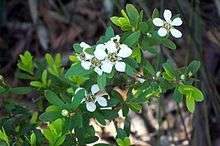Leptospermum grandifolium
| Woolly-tea Tree | |
|---|---|
 | |
| Ku-ring-gai Chase National Park, Australia | |
| Scientific classification | |
| Kingdom: | Plantae |
| (unranked): | Angiosperms |
| (unranked): | Eudicots |
| (unranked): | Rosids |
| Order: | Myrtales |
| Family: | Myrtaceae |
| Genus: | Leptospermum |
| Species: | L. grandifolium |
| Binomial name | |
| Leptospermum grandifolium Sm. | |
| Synonyms | |
The mountain tea-tree (Leptospermum grandifolium) is a tall Australian shrub, up to 6 metres high. Often seen near creeks on soils derived from sandstone. It may also be seen in sub-alpine areas near Mount Kosciuszko. The specific epithet grandifolium refers to the “large leaves”, in comparison with the smaller leaves of other plants in this group.
Three or five parallel veins may be seen on the leaves, which are around 1 to 3 cm long and 3 to 7 mm wide, having a sharp tip. The leaf's lower surface is felty, the top side is somewhat glossy. White flowers form singly, around 15 mm wide, usually from October to December. Fruiting capsules are hairy, 8 to 10 mm wide.[1]
References
This article is issued from
Wikipedia.
The text is licensed under Creative Commons - Attribution - Sharealike.
Additional terms may apply for the media files.